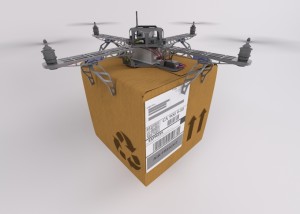Editor’s note: Leslie Townsend is CEO and Co-founder at research firm Kinesis Survey Technologies, Austin, Texas. This is an edited version of a post that originally appeared here under the title, “Drones and … market research?”
 With applications spanning a seemingly endless array of industries, drones – unmanned aerial systems (UAS), to be more precise – are the future. At least that is what speakers at the 2015 UAS Traffic Management Convention proclaimed.
With applications spanning a seemingly endless array of industries, drones – unmanned aerial systems (UAS), to be more precise – are the future. At least that is what speakers at the 2015 UAS Traffic Management Convention proclaimed.
Amazon.com has emerged as perhaps the most visible player in the commercial drone market. Ever since Amazon CEO Jeff Bezos appeared on 60 Minutes in December 2013 to discuss Amazon Prime Air, the company’s ambitions about delivery by drone in the U.S., the Internet has been buzzing (no pun intended).
Recently, Google made it apparent it wants in on the game as well. As part of the company’s restructuring to announce Alphabet – the holding company that will break out the core Google business from its other interests like driver-less cars, Nest, Google Fiber etc. – Alphabet CEO Larry Page made particular mention about the company’s plans for drones.
It is perhaps not surprising that two of the largest most innovative companies in the world are competing in the drone race but apparently they are not the only ones.
Although the unmanned aircraft industry is still in its infancy, it is poised to become one of the fastest-growing industries in American history. In 2014 the commercial drones market was valued at $15.22 million and is expected to reach $1.27 billion by 2020, says new research available at ReportsnReports.com. Industries positioned to benefit from UAS include real estate (photography), agriculture (crop management), public safety (search and rescue and fire management) and retail (parcel delivery).
Consumers are also buying drones in their millions, although there has been some unrest about the use of drones by the public and the need for tighter regulation. There are regulations in place covering the use of drones but given the expected growth in commercial drones, regulations are likely to be tightened.
What does this have to do with market research? Everything!
Given the estimated growth of this industry and the increase in competition for ads, eyeballs and consumer dollars, you better believe market research will have a huge stake in the ground. In fact, market research firms specialized in drone analytics are already cropping up. As an example, Drone Analyst Research and Advisers, a Redwood City, Calif.-based firm, offers research, insights and recommendations to help provide end-clients with information to make decisions toward integrating drones into their business model.
However, the time is probably closer than we think when a significant portion of end-clients will use drones as an additional channel to reach consumers and will therefore require integrated market research data – not from a specialized firm.
Whether or not we are looking at the dawn of a new era, it will be interesting to see how drone industry takes off (sorry, I couldn’t help myself) and the ripple effect it will have on seemingly every other industry.
